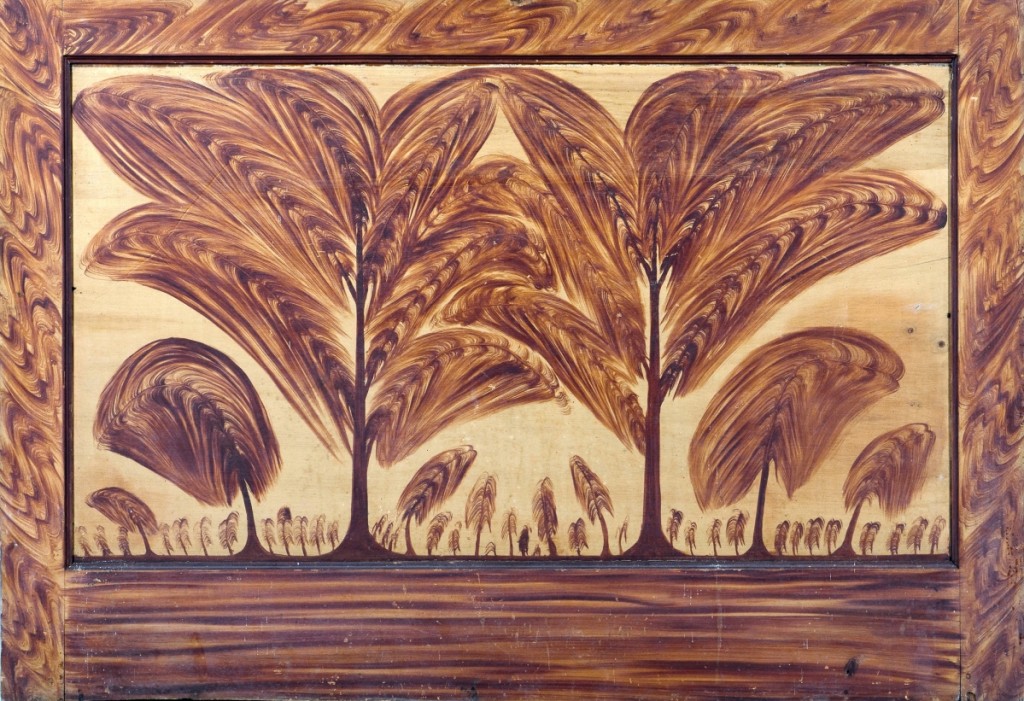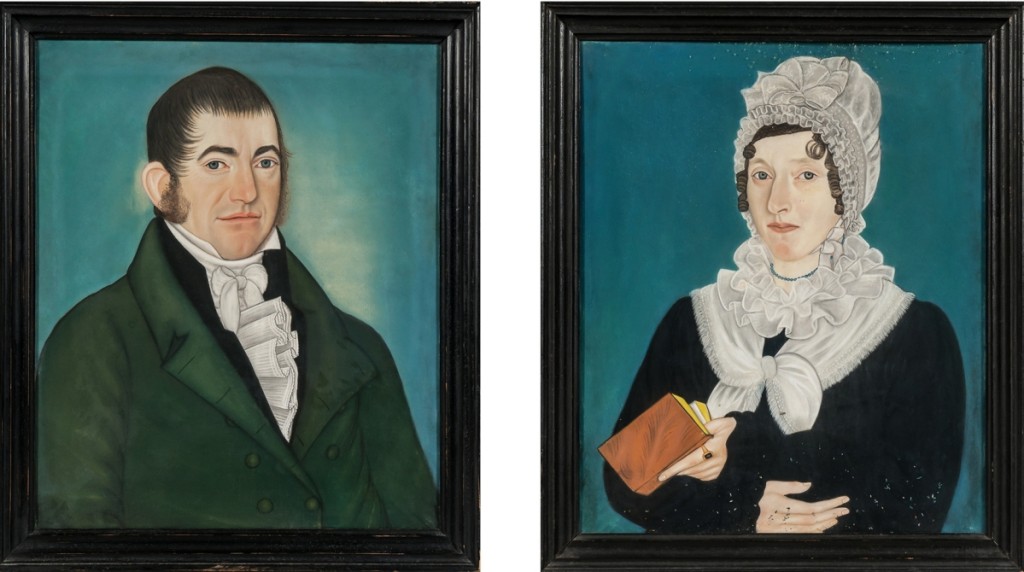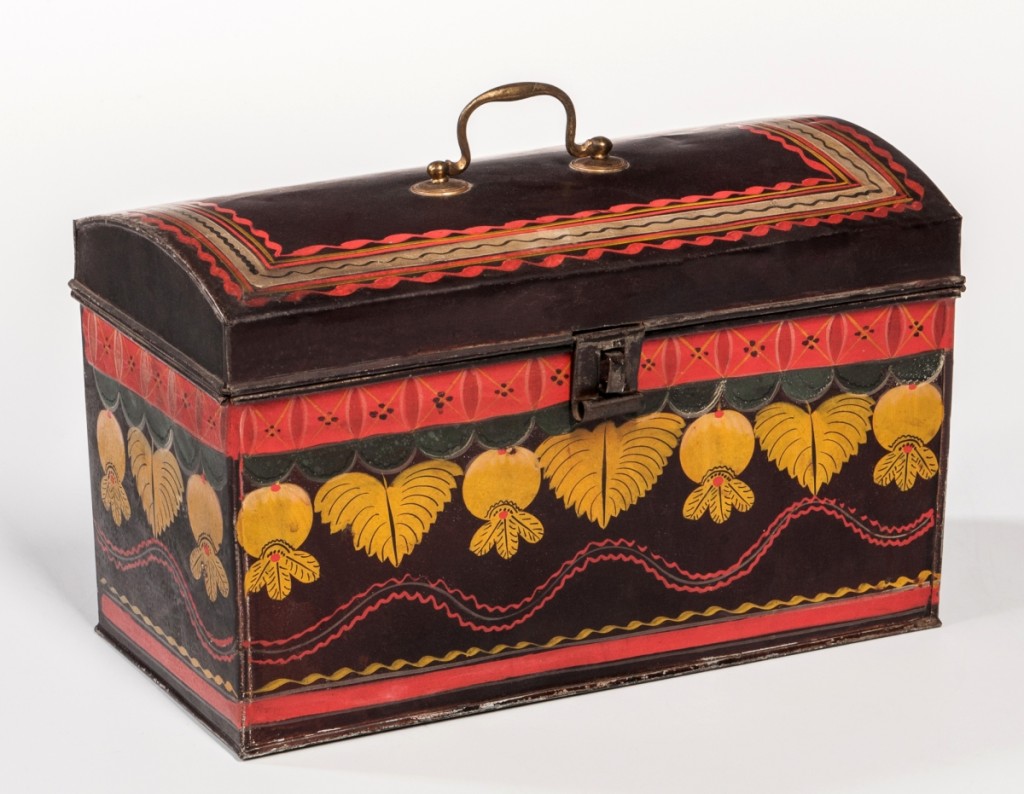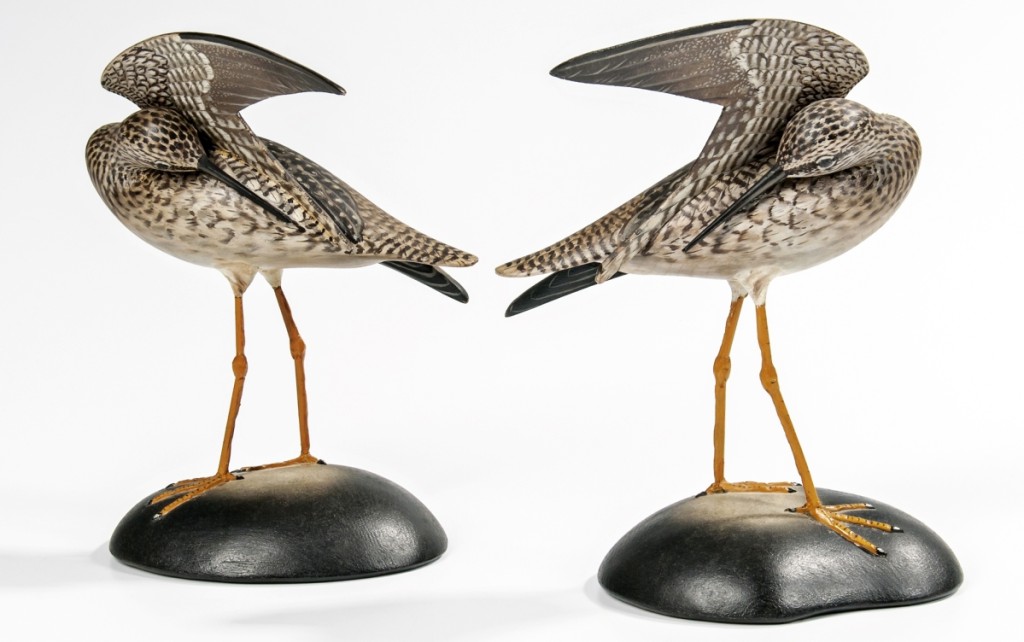
Bringing $86,100, the star of the two-day sale was a fireboard by an unidentified artist that had been made for the Amos Blazo house in North Parsonsfield, Maine, circa 1815-20. It depicted two large red/brown trees with several smaller trees on a cream-colored ground. It had remained in the house until 1984.
Review and Photos by Rick Russack
MARLBOROUGH, MASS. – August 11, day one of Skinner’s Americana sale, featured the collection of Marilyn and Don Forke, of Lincoln, Neb. They collected Pilgrim Century and Eighteenth Century furniture, needlework, ceramics and metal ware. They were particularly drawn to items with the heart motif, often the unifying factor in the objects they chose. The collection was built between the late 1960s and the 1980s, and detailed notes were kept regarding provenance. They bought from, and with the advice of, the leading dealers in those fields at that time, including Lillian Cogan, Roger Bacon, Cora Ginsberg and Mark Allen.
Collecting standards in those days differed from today. Cogan and Bacon accepted that a 200-year-old piece of furniture might have some repairs and later paint. If the form was good or rare, imperfections did not deter them or render a piece undesirable, and the Forkes agreed. Collectors today want surfaces to be original, paint to be original and furniture not to have been repaired. That change in standards was reflected in furniture prices, but in categories where standards have pretty much remained as they were, such as ceramics and metalware, prices were unaffected.
Skinner promoted the sale well, both with email and social media, and the firm produced a separate catalog for the Forke collection. That collection, in spite of some of the condition issues, grossed a little more than $871,500. The sale’s two-day total was $2,269,000, with more than 40 items selling for more than $10,000. And, in some unusual organization of the sale, two of the four highest prices came almost at the end of the second day. The sale’s highest price, $86,100, was achieved by a fireboard sold on the second day of the sale. Internet bidders bought about 40 percent of the lots and were underbidders on about one-third of the other lots. Multiple phone lines were active throughout the sale and there were numerous absentee bids.
Final results for the early furniture in the Forke collection depended on the degree of restoration and the condition of the surface. The highest priced item in the collection, bringing $24,600, far over the estimate, was a circa 1730-50 flat top Queen Anne high chest on particularly slim, cabriole legs. It had an old varnished surface; old replaced brasses; and a well-carved, beaded apron. Selling below the estimate, finishing at $17,200, was a circa 1670-1700 Peter Blinn carved, turned and joined Sunflower chest. It had been purchased from Lillian Cogan in 1981.

Winding up as the second highest priced lot of the sale was an unsigned pair of pastel-on-paper portraits of unidentified sitters by Micah Williams. The sitters were well-dressed, and the pair of paintings finished at $46,125.
An early Connecticut painted chest over one drawer, circa 1700, with an arch-molded case; painted floral blossoms; and vines in white, black and red with only minor restoration brought $14,760. But another joined chest over a single drawer, with the paint more heavily restored, had difficulty reaching $4,920 even though it was dated to 1690-1720. Other pieces that buyers were reluctant to consider included a Spanish-brown slant lid desk with a later surface that went out for $3,998 and a black-painted slant lid desk on frame, circa 1700-25, that fetched $3,690. Since the Forkes were drawn to the heart motif, it’s not surprising that there were a number of heart-and-crown chairs. Results also varied depending on the amount of restoration or refinishing. But there was no question that early metalware, pewter, English needlework and ceramics did well.
An early tin-glazed earthenware charger had several bidders competing. It was a late Seventeenth Century, 12þ-inch Bristol charger with a multi-color portrait of a mounted Charles II, and it earned $5,228. An 8þ-inch Bristol floral-decorated plate, dated 1728, earned $2,583; and a Bristol porringer, dated 1742, with a heart-pierced handle, brought $4,613. Salt-glazed stoneware also drew several competing bids. A press-molded 9-inch stoneware plate, Success to the King of Prussia and His Forces, circa 1760, with a mounted soldier, went for $1,476; and a group of three salt-glazed chargers – one of which was 17 inches diameter – along with a salt-glazed plate, all dating to 1750-75, earned $1,845. Earning more than four times the estimate was a lot with an Eighteenth Century inscribed puzzle jug with a heart-pierced handle, sold with two wine labels, which ended up at $2,583.
Second Day
The second day of the sale, August 12, included numerous folk and Outsider paintings, Chinese export porcelains, furniture, textiles and needlework, lighting, weathervanes, decoys, carousel figures, painted tinware, painted boxes and two fireboards. One of the fireboards had been made for the Amos Blazo house in North Parsonsfield, Maine, circa 1815-20, and had remained in the house until 1984. It was the star of the two-day sale, finishing at $86,100. It depicted two large red/brown trees on a cream-colored ground, done with broad strokes, and several smaller trees. David Schorsch was the underbidder on the fireboard and said that he was particularly attracted to its almost monochrome coloring. He thought it might have been the work of a furniture decorator, as he believed that there were similarities to the grain painting of some pieces of furniture. The next lot, another fireboard, this one attributed to Rufus Porter, which strongly resembled one that had come from a home in Greenfield, N.H., sold for $22,140.
Clearly, color was the determining factor in the many painted boxes and smalls offered throughout both days of the sale. An unusual Seventeenth Century red bookstand in the Forke collection brought $4,920. The attraction to color was proved again early on the second day, as a large, painted tin document box, decorated in a bright yellow floral pattern bordered by a bright red geometric frieze, sold for $15,990, far above the $400/600 estimate. If you’re wondering if it’s worth shopping at Goodwill and other thrift stores, be aware that this tin box was bought in an Albuquerque N.M., thrift store for $40.

This fancifully painted tin document had once been bought in a New Mexico thrift store for $40. It showed that bidders are willing to pay for colorfully decorated smalls, as it went out at $15,990.
The tin box was an indicator of things to come. One of the surprises late in the sale also reflected the serious interest in color. A circa 1830-40 red-painted Shaker blanket chest from the Enfield, N.H., community, that had been purchased from Doug Hamel in 2000 sold for $35,670. After the sale, a noted Shaker specialist conveyed that this result had the Shaker collecting world spinning in disbelief, wondering “why?”
The folk art selection included numerous folk paintings, and an unsigned pair of portraits by Micah Williams (1782-1837) ended up being the second highest priced lot in the sale. The sitters in the pastel-on-paper portraits were not identified, but they were well-dressed, and the pair finished at $46,125, going to a phone bidder. From 1829-33, Williams worked in New York City, then spent the rest of his life in New Jersey and is buried in New Brunswick. Another pair of unsigned portraits, these by George Hartwell (1815-1901), earned $8,610. An uncommon front-facing portrait of a young woman by Ruth Henshaw Miles Bascom (1772-1848) realized $7,380. It had come from the Bertram and Nina Fletcher Little sale at Sotheby’s, and a label on the back included a quote from Bascom’s journal (at the American Antiquarian Society) that dates the portrait to about 1842. An unsigned Ammi Philips portrait of a gentleman with a book in his hand went to a phone bidder for $6,675.
This portion of the sale also included a number of weathervanes, the most popular of which was a circa 1855-60 J. Howard and Co running horse of molded copper and zinc, which went out at $24,600. An Index horse weathervane, also by Howard, went for $12,300. An uncommon, full-bodied short-horn Jersey cow weathervane with a fine weathered surface, made by J.W. Fiske, circa 1896, brought $23,370. It had been commissioned by William Hayes of Tariffville, Conn., and had remained on his barn for a number of years.
The sale also included a selection of decoys. Topping that group was a lovely pair of carved and painted preening yellowlegs by Elmer Crowell. The pair went for $20,910. A carved curlew, signed “JK” that may have come from Virginia earned $584. There were also some fish decoys, but the most interesting “fish” was a brightly painted, two-sided trade sign, circa 1930, in the form of a fish, that advertised H.W. Sporting Goods of Milton, Penn. It sold for $4,305.

A nice pair of carved and painted preening yellowlegs, each with the rectangular Elmer Crowell mark on the base, realized $20,910. The sale included a number of decoys and decorative carvings.
Steve Fletcher shared a photocopy of an illustrated circa 1978 promotional brochure for the company written by Bob Skinner. It includes the history of the company – the first auction was in 1962 – before a permanent gallery was built in the early 1970s. Skinner was very proud of some of the innovations incorporated in that first gallery in Bolton, such as revolving stages for the display of furniture and the 1977 installation of an IBM computer system – the first, he said, by a major auction facility. In 1978, Skinner opened a gallery in Copley Square. Skinner discussed the major early sales conducted by the company, such as the Charles Gardner collection of American glass, which grossed more than $1 million in the mid-1970s, and other landmark sales and significant prices achieved for individual items. He discusses the reasons clients should sell at auction, especially through Skinner, as opposed to selling privately, and ends with his “projections for the future,” which, unfortunately, did not go into much detail. At the time, the company had seven separate departments, including one for Victorian furniture. Today, it has more than 20. Two of the American furniture specialists listed at the time are with the company today – Karen Keane, presently company president and chief executive officer, and Steve Fletcher, presently director of American furniture and decorative arts and executive vice president. One can only wonder what Bob Skinner, who died in 1984 at the age of 52, would have to say about the role of the internet and what he would have thought, in 2019, about the company he founded more than 55 years earlier.
A few days after the sale, Fletcher said, “We did well. We had a lot of great things to sell, and the Monday sale didn’t end until 8:20 pm. Needless to say, there weren’t a lot of folks left in the sales room by then. We had more than 700 requests for condition reports. That’s a pretty good indication of the level of interest. There were plenty of surprises: the ram weathervane, which sold for $12,300, was a surprise and so was the needlework and watercolor cut-out memorial for Mary Perkins. It came from a Jaffrey, N.H., home and sold for $9,840. I also didn’t expect that the Shaker blanket chest would finish as high as it did.”
Prices given include the buyer’s premium, as stated by the auction house. For more information, www.skinnerinc.com or 508-970-3200.




























